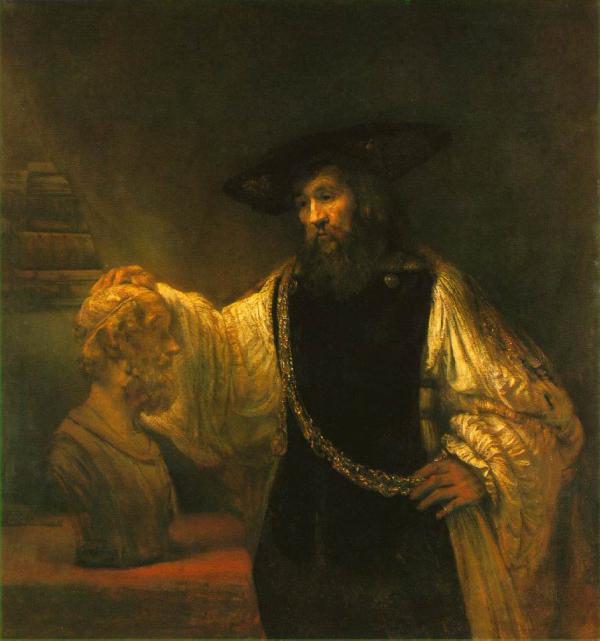Rembrandt, the greatest of all the Baroque masters settled in Amsterdam in 1631. He took a sensuous interest and delight in the physical qualities of his medium, independence from the subject. He caked his surfaces with more paint than necessary, replaced exact imitation of form by the suggestion of it, and used a brown ground so that his paintings emerged from dark to light. He worked in complex layers, building up a picture from the back to the front with delicate glazes that allowed light to permeate his backgrounds and reflect off the white underpainting.
|
|
 Viewer |
Aristotle contemplating a bust of Homer 1653 Oil on canvas 143.5 x 136.5 cm Metropolitan Museum of Art, New York Bredius 478 Rembrandt had one foreign patron, a Sicilian nobleman, who asked him to paint a philosopher. The request came at a time when Rembrandt had become embroiled in serious financial trouble, and this commission seems to have sparked off some deep inner response. The combination of his personal anxieties and the idea of philosophy drew from Rembrandt one of his greatest masterpieces, in which he contrasts two ways of being a genius. He ponders visually the importance in life of material success, fame, and power, compared with being true to art. He does so by confronting the greatest Greek philosopher, Aristotle, with the greatest Greek poet, Homer. In the 4th century B.C., philosophy included the whole of science, and Aristotle understood it, integrated and systemized it. He was dazzlingly successful. We see his rich, wide, silken sleeves - those of a man who does not need to work - and, above all, his thick gold chain. The chain was a gift from Aristotle's most prestigious pupil, Alexander the Great, who had left Aristotle an enormous fortune, but whom the philosopher had failed to influence spiritually. Rembrandt imagines Aristotle in all his fame and wealth, looking at a bust of the great blind poet Homer. From the meagerness of the bust, we can see that Homer was poor. He wandered around Greece with his harp, playing at evening parties, and earning a pittance. Homer was true to his genius: he made no money from his art, and he did not care. With the medallion, representing both his great material success and his great teaching failure, swinging between them, Aristotle ponders - and Rembrandt with him: What matters most? How can one be certain that one is not selling out? Of course, I can say nothing about Aristotle, but I am certain that Rembrandt never sold out. Perhaps it was precisely these moments of profound self-questioning that kept him pure. |
| Aristotle contemplating Homer | Self Portrait | David and Jonathan | Raising of Lazarus | Mill | Return of the prodigal son | Jewish Bride |
| Renowned Artists Gallery index (61 galleries)
Other Parts of the Permanent Gallery | ||
| Digital Color Winners 2004 and 2005
Digital Color Winners 2002 and 2003 Digital Color Winners 1999, 2000 and 2001 |
Watercolor Painters
Oil Painters Pen and Pencil Artists |
Photographers
Sculptors Authors |